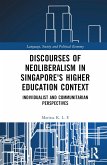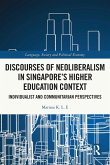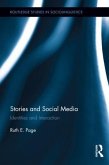Social Identity and Discourses in Chinese Digital Communication
Herausgeber: Zhu, Hongqiang; Chen, Xinren; Feng, Debing
Social Identity and Discourses in Chinese Digital Communication
Herausgeber: Zhu, Hongqiang; Chen, Xinren; Feng, Debing
- Gebundenes Buch
- Merkliste
- Auf die Merkliste
- Bewerten Bewerten
- Teilen
- Produkt teilen
- Produkterinnerung
- Produkterinnerung
Examining how diverse social identities are constructed in digital communication in China, this edited collection provides a multi-dimensional exploration of the diverse, discursive forms and practices used to construct and present the "self" online.
Andere Kunden interessierten sich auch für
![Discourses of Identity in Liminal Places and Spaces Discourses of Identity in Liminal Places and Spaces]() Discourses of Identity in Liminal Places and Spaces167,99 €
Discourses of Identity in Liminal Places and Spaces167,99 €![Discourses of Neoliberalism in Singapore's Higher Education Context Discourses of Neoliberalism in Singapore's Higher Education Context]() Marissa K. L. EDiscourses of Neoliberalism in Singapore's Higher Education Context149,99 €
Marissa K. L. EDiscourses of Neoliberalism in Singapore's Higher Education Context149,99 €![Discourses of Neoliberalism in Singapore's Higher Education Context Discourses of Neoliberalism in Singapore's Higher Education Context]() Marissa K. L. EDiscourses of Neoliberalism in Singapore's Higher Education Context56,99 €
Marissa K. L. EDiscourses of Neoliberalism in Singapore's Higher Education Context56,99 €![Discourses of the Arab Revolutions in Media and Politics Discourses of the Arab Revolutions in Media and Politics]() Stefanie UllmannDiscourses of the Arab Revolutions in Media and Politics167,99 €
Stefanie UllmannDiscourses of the Arab Revolutions in Media and Politics167,99 €![Stories and Social Media Stories and Social Media]() Ruth E. PageStories and Social Media186,99 €
Ruth E. PageStories and Social Media186,99 €![Entangled Discourses Entangled Discourses]() Entangled Discourses55,99 €
Entangled Discourses55,99 €![Multidisciplinary Approaches to the Discourses of Extremism Multidisciplinary Approaches to the Discourses of Extremism]() Multidisciplinary Approaches to the Discourses of Extremism191,99 €
Multidisciplinary Approaches to the Discourses of Extremism191,99 €-
-
-
Examining how diverse social identities are constructed in digital communication in China, this edited collection provides a multi-dimensional exploration of the diverse, discursive forms and practices used to construct and present the "self" online.
Produktdetails
- Produktdetails
- Verlag: Routledge
- Seitenzahl: 250
- Erscheinungstermin: 14. November 2024
- Englisch
- Abmessung: 240mm x 161mm x 18mm
- Gewicht: 543g
- ISBN-13: 9781032582726
- ISBN-10: 1032582723
- Artikelnr.: 70600970
- Herstellerkennzeichnung
- Libri GmbH
- Europaallee 1
- 36244 Bad Hersfeld
- gpsr@libri.de
- Verlag: Routledge
- Seitenzahl: 250
- Erscheinungstermin: 14. November 2024
- Englisch
- Abmessung: 240mm x 161mm x 18mm
- Gewicht: 543g
- ISBN-13: 9781032582726
- ISBN-10: 1032582723
- Artikelnr.: 70600970
- Herstellerkennzeichnung
- Libri GmbH
- Europaallee 1
- 36244 Bad Hersfeld
- gpsr@libri.de
Hongqiang Zhu is Professor of Linguistics at Jinan University, Guangzhou, China. Debing Feng is Professor of Linguistics at Hangzhou Normal University, China. Xinren Chen is Professor of English and Linguistics at Nanjing University and Executive Director of the China Research Center for Language Strategies, China.
Introduction: Approaching Social Identities and Discourses in Chinese
Digital Communication; Part I: Representation: Pragmatics, conversations,
corpus linguistics; Chapter 1. Chinese medical professionals' self-identity
construction in Xiaohongshu medical knowledge disseminating accounts by
Xinren Chen, Ruixin Cheng; Chapter 2. Constructing the image of a "corrupt
official" in the discourse of Weibo interaction: The case of the "Brother
Watch" event by Debing Feng and Xiaoping Wu; Chapter 3. Gender performances
of male and female politicians on social media: A corpus-assisted discourse
study by Ming Liu, Ruinan Zhao; Part II: Multimodality and
self-presentation; Chapter 4. Visual exclusion: Representation of Chinese
youth on Chinese social media by Rongle Tan, Yiqiong Zhang and Huiting Dai;
Chapter 5. The presentation of self in 'travelogues' on Chinese WeChat
Moments by Pan Pan, Hongqiang Zhu and Xinyu Liu; Chapter 6. Crossing
boundaries: How do Chinese influencers navigate pedagogical, therapeutic,
and rapport discourses and identities in live streaming commerce? by Panpan
Zhang (Penny), Tao Xiong, Yi Shi, Qi Huang and Xianghua Yan; Part III:
Social identity, platforms and social capital; Chapter 7. Cultural
identities of 'Chinese' style uploaders on digital platforms by Xin Zeng;
Chapter 8. Social media for the health campaign and solidarity among
Chinese fandom publics during the COVID-19 pandemic by Qiaolei Jiang, Shiyu
Liu, Yue Hu and Jing Xu; Chapter 9. Representing linguistic and cultural
diversity in a Chinese video game by Jia L and Guorong Hao
Digital Communication; Part I: Representation: Pragmatics, conversations,
corpus linguistics; Chapter 1. Chinese medical professionals' self-identity
construction in Xiaohongshu medical knowledge disseminating accounts by
Xinren Chen, Ruixin Cheng; Chapter 2. Constructing the image of a "corrupt
official" in the discourse of Weibo interaction: The case of the "Brother
Watch" event by Debing Feng and Xiaoping Wu; Chapter 3. Gender performances
of male and female politicians on social media: A corpus-assisted discourse
study by Ming Liu, Ruinan Zhao; Part II: Multimodality and
self-presentation; Chapter 4. Visual exclusion: Representation of Chinese
youth on Chinese social media by Rongle Tan, Yiqiong Zhang and Huiting Dai;
Chapter 5. The presentation of self in 'travelogues' on Chinese WeChat
Moments by Pan Pan, Hongqiang Zhu and Xinyu Liu; Chapter 6. Crossing
boundaries: How do Chinese influencers navigate pedagogical, therapeutic,
and rapport discourses and identities in live streaming commerce? by Panpan
Zhang (Penny), Tao Xiong, Yi Shi, Qi Huang and Xianghua Yan; Part III:
Social identity, platforms and social capital; Chapter 7. Cultural
identities of 'Chinese' style uploaders on digital platforms by Xin Zeng;
Chapter 8. Social media for the health campaign and solidarity among
Chinese fandom publics during the COVID-19 pandemic by Qiaolei Jiang, Shiyu
Liu, Yue Hu and Jing Xu; Chapter 9. Representing linguistic and cultural
diversity in a Chinese video game by Jia L and Guorong Hao
Introduction: Approaching Social Identities and Discourses in Chinese
Digital Communication; Part I: Representation: Pragmatics, conversations,
corpus linguistics; Chapter 1. Chinese medical professionals' self-identity
construction in Xiaohongshu medical knowledge disseminating accounts by
Xinren Chen, Ruixin Cheng; Chapter 2. Constructing the image of a "corrupt
official" in the discourse of Weibo interaction: The case of the "Brother
Watch" event by Debing Feng and Xiaoping Wu; Chapter 3. Gender performances
of male and female politicians on social media: A corpus-assisted discourse
study by Ming Liu, Ruinan Zhao; Part II: Multimodality and
self-presentation; Chapter 4. Visual exclusion: Representation of Chinese
youth on Chinese social media by Rongle Tan, Yiqiong Zhang and Huiting Dai;
Chapter 5. The presentation of self in 'travelogues' on Chinese WeChat
Moments by Pan Pan, Hongqiang Zhu and Xinyu Liu; Chapter 6. Crossing
boundaries: How do Chinese influencers navigate pedagogical, therapeutic,
and rapport discourses and identities in live streaming commerce? by Panpan
Zhang (Penny), Tao Xiong, Yi Shi, Qi Huang and Xianghua Yan; Part III:
Social identity, platforms and social capital; Chapter 7. Cultural
identities of 'Chinese' style uploaders on digital platforms by Xin Zeng;
Chapter 8. Social media for the health campaign and solidarity among
Chinese fandom publics during the COVID-19 pandemic by Qiaolei Jiang, Shiyu
Liu, Yue Hu and Jing Xu; Chapter 9. Representing linguistic and cultural
diversity in a Chinese video game by Jia L and Guorong Hao
Digital Communication; Part I: Representation: Pragmatics, conversations,
corpus linguistics; Chapter 1. Chinese medical professionals' self-identity
construction in Xiaohongshu medical knowledge disseminating accounts by
Xinren Chen, Ruixin Cheng; Chapter 2. Constructing the image of a "corrupt
official" in the discourse of Weibo interaction: The case of the "Brother
Watch" event by Debing Feng and Xiaoping Wu; Chapter 3. Gender performances
of male and female politicians on social media: A corpus-assisted discourse
study by Ming Liu, Ruinan Zhao; Part II: Multimodality and
self-presentation; Chapter 4. Visual exclusion: Representation of Chinese
youth on Chinese social media by Rongle Tan, Yiqiong Zhang and Huiting Dai;
Chapter 5. The presentation of self in 'travelogues' on Chinese WeChat
Moments by Pan Pan, Hongqiang Zhu and Xinyu Liu; Chapter 6. Crossing
boundaries: How do Chinese influencers navigate pedagogical, therapeutic,
and rapport discourses and identities in live streaming commerce? by Panpan
Zhang (Penny), Tao Xiong, Yi Shi, Qi Huang and Xianghua Yan; Part III:
Social identity, platforms and social capital; Chapter 7. Cultural
identities of 'Chinese' style uploaders on digital platforms by Xin Zeng;
Chapter 8. Social media for the health campaign and solidarity among
Chinese fandom publics during the COVID-19 pandemic by Qiaolei Jiang, Shiyu
Liu, Yue Hu and Jing Xu; Chapter 9. Representing linguistic and cultural
diversity in a Chinese video game by Jia L and Guorong Hao








